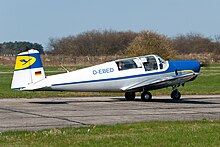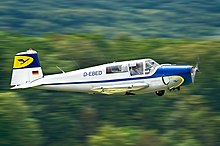Saab 91
| Saab 91 Safir | |
|---|---|
 Saab 91B in the Flygvapenmuseum |
|
| Type: | * Liaison aircraft |
| Design country: | |
| Manufacturer: | |
| First flight: |
November 20, 1945 |
| Number of pieces: |
323 |
The Saab 91 Safir is an aircraft from the Swedish manufacturer Saab . It is a single - engine, low - wing aircraft with a retractable tricycle landing gear . 323 pieces of all versions were produced. Deliveries were made to 21 countries and a total of six air forces.
development

The development of the initially three-seat machine began in the winter of 1944/45 and was headed by Anders J. Andersson . 200,000 Swedish kronor were approved as development costs. The first flight took place on November 20, 1945 with a 130 hp De Havilland Gipsy Major IC engine , which drove an adjustable two-bladed propeller. The plane offered space for three people. This prototype (SE-APN) was rebuilt in 1947 to be used as a test aircraft for the wing development of the Saab 29 , named Saab 201 . The wings that were intended for the Saab 29 were scaled down. It started in this configuration on April 28, 1947 for the first time. In 1950 the same aircraft was rebuilt again and, with the designation Saab 202, the Saab 32 was also used for this purpose. The first flight took place here on March 1, 1950.
Technical version (Saab 91A)
The cantilevered wing was designed as a single spar and bolted to the fuselage. The front part of the wing was planked with sheet metal up to the spar and covered with cloth behind it. The ailerons were made of cloth-covered Alclad . The aileron on the port side had an adjustable trim surface on the ground. Mechanically operated landing flaps designed as split flaps were located between the ailerons and the fuselage . The hull was designed to be self-supporting. The frames were connected by stringers and covered with a supporting sheet metal skin made of Alclad. The tail unit was designed to be self-supporting and consisted of Alclad covered with sheet metal. The oars were covered with cloth. Both elevator and rudder were trimmable. The machine had a double rudder. The nose wheel landing gear was operated mechanically. The main landing gear retracted inwards towards the fuselage, the nose wheel backwards. The wheel brakes of the main landing gear were operated by toe pedals. The cabin was closed on all sides. The three-part roof glazing could be thrown off in an emergency. The pilot sat on the left, with a passenger next to it. Another passenger seat was located behind the passenger. The luggage compartment was behind the pilot. The passenger seats could be removed for the transport of a stretcher.
Saab 91A
Series production of the Saab 91A began in the spring of 1946. Of this first series, equipped with a De Havilland Gipsy Major 10 with an output of 147 hp, 48 units could be produced by 1948, ten of which were bought by the Swedish Air Force and used as a liaison aircraft Tp 91 to 1960 were used. Eight machines were sold to the Dutch state air transport school, and the Ethiopian Air Force bought 16 machines. One machine was flown by Carl Gustaf von Rosen from Stockholm to Addis Ababa in a non-stop transfer flight that lasted 30:52 hours . The remaining 14 machines of the first series were bought by private individuals.
Saab 91B
On January 18, 1949, the Saab 91B version, equipped with a Lycoming O-435A , took off on its maiden flight. Because of the boxer engine, the bow area was redesigned. Compared to the Saab 91A, the cockpit glazing had also been changed, and now an adjustable three-blade propeller was used. The Swedish Air Force had selected the Saab 91 as a training aircraft and ordered 75 aircraft. The engine developed 190 hp and enabled better flight performance. Due to capacity problems at Saab, De Schelde in Dordrecht was granted a production license, according to which 120 pieces were produced. From 1952 the Saab 91B was used as a training aircraft by the Swedish Air Force as the Sk 50B . At the end of 1954, after the Saab plant was expanded, production was resumed in Sweden. The Norwegian Air Force bought 25 copies of a version called the Saab 91B-2 . The fuselage of the Saab 91B was used, on which the wings of the Saab 91C, but without built-in tanks, were mounted. The Norwegians later took over five Swedish Sk 50Bs. Another military user was the Ethiopian Air Force with 14 Saab 91Bs.
Civil users were Air France with five, the Indonesian civil aviation school with six, Lufthansa with two and Sabena with eight machines.
A Sk 50B machine was bought back by Saab and sold to the Japanese Technical Research and Development Institute in 1957, which is maintained by the Japanese Armed Forces. There it was converted into a STOL aircraft. Due to the possibility of simply exchanging the wings, the machine was used until 1987 and then handed over to a museum.
Saab 91C
The Saab 91C was a four-seater variant that made its maiden flight in September 1953. The wings received fuel tanks so that the fuselage tank could be omitted. The Swedish Air Force used 14 machines of this design as the Sk 50C .
Saab 91D
The last version delivered was the Saab 91D, presented in 1957, which, also with four seats, was equipped with a 180 hp Lycoming O-360A1A as a drive. Disc brakes were used here as wheel brakes. Various design changes reduced the weight of the machine. The Austrian Armed Forces ordered 24 machines as training aircraft, which were used between 1964 and September 13, 1993. Other users were the Finnish Air Force with 16 machines, two of which were equipped with cameras as reconnaissance aircraft, the Dutch Air Force with 16 and the Tunisian Air Force with 15 aircraft of this type. The last Saab Safir left the factory in Sweden on July 8, 1966.
Further use
The Swedish Air Force used the Sk 50 as a training aircraft until 1971 and as a liaison aircraft until 1993. The machines were then given to aviation clubs at low cost and some are still in use today.
The Safir was also used as an aerobatic plane. The Breitling Eagles and Team 2000, among others, still use these aircraft at some air shows. Until 1993, an aerobatic team of the Austrian Armed Forces , the Karo As , flew eight Safir of the 91D series, which were then sold to the 2000 team.
Military users
-
 Ethiopia : 16 Saab 91A, 14 Saab 91B
Ethiopia : 16 Saab 91A, 14 Saab 91B -
 Finland : Air Force: 16 Saab 91D, border guards 3 Saab 91D (1982–1985)
Finland : Air Force: 16 Saab 91D, border guards 3 Saab 91D (1982–1985) -
 Japan : 1
Japan : 1 -
 Norway : 25 Saab 91B-2
Norway : 25 Saab 91B-2 -
 Austria : 24 (1964 to 1993)
Austria : 24 (1964 to 1993) -
 Sweden : 10 Saab 91A, 75 Saab 91B (Sk-50B), 14 Saab 91C (Sk-50C)
Sweden : 10 Saab 91A, 75 Saab 91B (Sk-50B), 14 Saab 91C (Sk-50C) -
 Tunisia : 15 Saab 91D
Tunisia : 15 Saab 91D
Technical specifications
| Parameter | Saab 91A | Saab 91B | Saab 91C | Saab 91D |
|---|---|---|---|---|
| length | 7.8 m | 7.95 m | 8.03 m | |
| span | 10.6 m | |||
| height | 2.20 m | |||
| Wing extension | 8.3 | |||
| Wing area | 13.6 m² | |||
| Cabin width | 1.22 m | |||
| Empty mass | 580 kg | 720 kg | 745 kg | |
| Takeoff mass | 955 kg | 1250 kg | 1215 kg | 1205 kg |
| Max. Takeoff mass | 1075 kg | |||
| Max. Takeoff mass aerobatics | 1050 kg | 1050 kg (+ 6 / −3 g ) | ||
| Top speed | 265 km / h | 275 km / h | 270 km / h | |
| Cruising speed | 248 km / h | 232 km / h | 227 km / h | 235 km / h |
| Stall speed | 85 km / h | 90 km / h | 90 km / h | |
| Climb performance | 300 m / min | 350 m / min | 255 m / min | 243 m / min |
| Range | 960 km | 1075 km | 960 km | 1060 km |
| Service ceiling | 4600 m | 6200 m | 5100 m | 6100 m |
Museum reception
- A Saab 91D Safir of the Austrian Armed Forces is on display in the military aviation exhibition Zeltweg in Hangar 8 of the Hinterstoisser Air Base , a branch of the Vienna Army History Museum .
Incidents

On August 1, 2014, a Saab 91B (D-EBED) crashed shortly after take-off at Bremen Airport . The pilot had previously reported that he had to turn back immediately. Radio contact then broke off and the aircraft crashed almost vertically into a warehouse, after which a fire broke out. The pilot was the experienced Lufthansa pilot Matthias S. (47), who left a wife and two children. The passenger, Alberto Pericoli, was a forty-six-year-old Italian aviation journalist who also left a wife and two children.
See also
- Bücker Bü 181 (designer Anders J. Andersson )
Web links
- Ärna Flygclubb
- FC Flygkubb
- SibWings lab - Microsoft Flight Simulator 2004 add-on - SAAB 91 Safir
- SAAB 91 D Safir - HB-DBL
- Austrian aerobatic swarm team 2000
swell
- The Saab-Scania Story. Streiffert & Co Stockholm 1987, ISBN 91-7886-014-8 .
- Jane's all the world's aircraft. 1956/57.
- www.vectorsite.net
- A flight through the ages. Flygvapenmuseum, 2002, ISBN 91-973957-1-4 .
- Saab 91D flight manual. May 1958.
Individual evidence
- ↑ on doppeladler.com , accessed on September 10, 2013
- ↑ Jens Eisenreich: Accidents and disruptions in the operation of civil aircraft, August 2014. (PDF) In: Interim report. Federal Bureau of Aircraft Accident Investigation , November 2014, pp. 16–24 , accessed on April 8, 2015 (file number: BFU 3X080-14).
- ↑ Christian Weth: Inmates died on impact. Weser Kurier, August 5, 2014, accessed on August 7, 2014 .
- ↑ Kreiszeitung media group: Huckelriede after the plane crash: mourning for the Lufthansa pilot and passenger - the shock continues. Kreiszeitung.de, August 4, 2014, accessed on August 7, 2014 .
- ↑ Aereo caduto a Brema, forse a bordo l'italiano Alberto Pericoli: serve il dna. Blitz quotidiano, August 4, 2014, accessed August 7, 2014 .



